Home | Class News | 50th Reunion | Past Reunions | Other Gatherings | Newsletter Archive | Links | Memorials | Classmates Search | Classmates Found | Trivia | Former Faculty | Contacts |
Remembering John Castellani
Ned Groth, April 2005
(Author’s note: This biographical remembrance is based heavily on documents, primarily back issues of the class newsletter, and notes on phone conversations I had with John. It also contains some of my own subjective impressions. My goal is to create an honest and loving portrait of our classmate. The task is more difficult in this case, because it was not begun until a dozen years after John’s death. While I’ve striven for factual accuracy, I take full responsibility for any errors of interpretation I may have made, and this document can be amended, or corrected, if it needs to be. –NG)
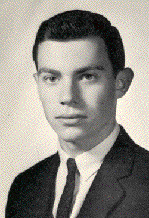 John joined our class for our senior year at Darrow, so he spent just a single year among our ranks. He roomed with Bill Anthony and Bob Sherwood, up in Ann Lee. Like Bob, John hailed from Troy, NY, at that point in his life. He and I were on the JV soccer team together, where as I recall, he played fullback, but I did not know him very well at Darrow. I got to know him a little better over the years after we graduated.
John joined our class for our senior year at Darrow, so he spent just a single year among our ranks. He roomed with Bill Anthony and Bob Sherwood, up in Ann Lee. Like Bob, John hailed from Troy, NY, at that point in his life. He and I were on the JV soccer team together, where as I recall, he played fullback, but I did not know him very well at Darrow. I got to know him a little better over the years after we graduated.
 John always struck me as very smooth, and socially graceful. We saw him as an urbane sophisticate, or at least that’s what the gag photo with his senior portrait in the yearbook suggests. In the rest of the yearbook, John appears in only that JV soccer team photo, as far as sports go, but he was a member of several clubs and service groups, including the Press Club, the Philosophy and Religion Seminar, and the Art Club, and he worked in the Milk Bar. In his single year at Darrow, John proved easy to like and seemed well rounded and serious about intellectual pursuits.
John always struck me as very smooth, and socially graceful. We saw him as an urbane sophisticate, or at least that’s what the gag photo with his senior portrait in the yearbook suggests. In the rest of the yearbook, John appears in only that JV soccer team photo, as far as sports go, but he was a member of several clubs and service groups, including the Press Club, the Philosophy and Religion Seminar, and the Art Club, and he worked in the Milk Bar. In his single year at Darrow, John proved easy to like and seemed well rounded and serious about intellectual pursuits.



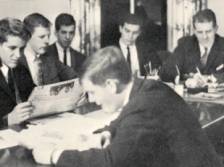
After Darrow, John went to Boston University, where he majored in history. In 1966, he married Jerilyn Byrne, and they had two children, Jonathan (born 1967) and Anna (1971). I lost touch with John during those years, reconnecting with him after I began writing the class newsletter. John contributed occasional news to the newsletter, and I saw him regularly at regional Darrow events. From 1975 to ’79, we both lived in the Washington, DC area, and from the mid ‘80s until his death in 1993, we both lived in New York. We ran into each other at alumni receptions, telethons and the like, and I also spoke to him on the phone fairly frequently. This biography is pieced together from my recollections of those encounters, plus the written records in our class newsletters.
The first news of John in the ’62 newsletter came in 1972, when I reported a new address that the school had given me. John, Jerilyn and the kids were living in Alexandria, VA. We didn’t know yet what he was doing there, but he had indicated that they planned to attend our 10th reunion, so we looked forward to catching up with them then. And they did attend, braving the rains from tropical storm Agnes, to drive up to Darrow, where we had a soggy but enthusiastic reunion. I learned then, and reported in the next newsletter, that John was working as a research historian at Mount Vernon, the home of George Washington, and he enjoyed it very much. During the reunion, John called Bob Sherwood and tried unsuccessfully to persuade him to come over to join our party.
In 1975, I moved to Washington, DC, and for the next several years, I saw or talked to John fairly often. In 1975, my mother-in-law and a couple of her friends from Eugene, OR visited us to see the sights in and around Washington, and John was kind enough to offer them a private tour of Mount Vernon, which Alice (my wife at the time) went along on. I didn’t get to go on the tour (had to work that day) but I did call John to thank him, and caught up a bit. He was still very happy with his work for the Mount Vernon Ladies Association of the Union, the organization that owns and operates Mount Vernon. He had also opened a small antique store, and Jerilyn was selling real estate in Washington. His job and the antique shop had him working too hard, but otherwise they seemed to be thriving. He had seen Bob Sherwood (then living in Boston) regularly each summer, and was hoping to get together with Bill Anthony as soon as Bill could get down to Virginia.
In December of 1975, Dave Miller and Steve Howard from Darrow came to Washington for one of their traveling slide shows, and I ran into John and Jerilyn at the gathering. With the US bicentennial approaching, things were busy at Mount Vernon, where a son-et-lumiére show, a bicentennial gift from France, was to be presented all summer. A year or so later, when I was calling people about our 15th reunion, I spoke with John again. He couldn’t make the reunion, was too busy with work (still at Mount Vernon, where he’d been promoted to assistant director), plus the antiques shop, and they were building a new house in Alexandria, hoping to move in that September. The next spring (1978), I saw John and Jerilyn at another Darrow cocktail party for alumni, parents and friends in the Washington area. They had moved into their new house the prior fall, and were hoping to get Bob Sherwood to come down for a visit.
The 1979 class newsletter reported that John was now “running” Mount Vernon. Now that he was in charge, his attention had shifted increasingly to fundraising, so that they could display a greater part of the large collection that the Association possessed, much of which was stored out of public view, for lack of display facilities and staff. John also said he was considering hosting a Darrow gathering at Mount Vernon—a lovely setting that should draw an appreciative crowd. He reported that the kids kept getting bigger—Jonathan was 12 now, and Anna had just turned 8.
The folks in the Darrow development office sent me a clipping from the NY Times of November 29, 1979, describing how John, whose title was now Resident Director of Mount Vernon, took part in an auction at Christie’s, bidding on a set of letters from the Earl of Chesterfield to his son. Those letters had once belonged to George Washington, and for a mere $15,000, the Mount Vernon Ladies Association restored them to the Mount Vernon library’s collection.
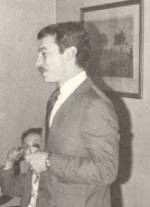 In May of 1980, John fulfilled his ambition to host a Darrow event at Mount Vernon. These photos from the Peg Board were taken at an almost identical gathering, two years later. Unfortunately, I couldn’t attend, since I had moved to New York in late 1979. But it was a wonderful evening, with cocktails on the South Lawn and patio overlooking the Potomac River, and dinner at the Director’s House. Which, by the way, was now John and Jerilyn’s residence; the Association provided a house at Mount Vernon for its director. John was hoping to make a Darrow reception at Mount Vernon an annual event. When I spoke with him on the phone, he said his work these days was mostly fundraising, but he was still enjoying it, and seemed delighted to be able to serve Darrow in this fashion.
In May of 1980, John fulfilled his ambition to host a Darrow event at Mount Vernon. These photos from the Peg Board were taken at an almost identical gathering, two years later. Unfortunately, I couldn’t attend, since I had moved to New York in late 1979. But it was a wonderful evening, with cocktails on the South Lawn and patio overlooking the Potomac River, and dinner at the Director’s House. Which, by the way, was now John and Jerilyn’s residence; the Association provided a house at Mount Vernon for its director. John was hoping to make a Darrow reception at Mount Vernon an annual event. When I spoke with him on the phone, he said his work these days was mostly fundraising, but he was still enjoying it, and seemed delighted to be able to serve Darrow in this fashion.

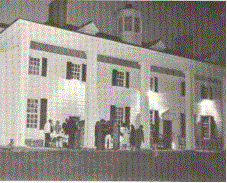 I next saw John in 1981, when the Metropolitan Museum of Art opened its Shaker room. Many of the furnishings on display had come from the North Family Dwelling at Darrow, when it was dismantled by Hands-to-Work crews, after the school acquired the North Family property in 1973. John came up to New York from Mount Vernon for the event, and was joined by John and Jean Joline, and several officials from Darrow. I spoke to him soon afterward, gathering news, and he was as busy as ever at Mount Vernon, preparing to launch a $10 million capital campaign.
I next saw John in 1981, when the Metropolitan Museum of Art opened its Shaker room. Many of the furnishings on display had come from the North Family Dwelling at Darrow, when it was dismantled by Hands-to-Work crews, after the school acquired the North Family property in 1973. John came up to New York from Mount Vernon for the event, and was joined by John and Jean Joline, and several officials from Darrow. I spoke to him soon afterward, gathering news, and he was as busy as ever at Mount Vernon, preparing to launch a $10 million capital campaign.
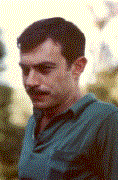
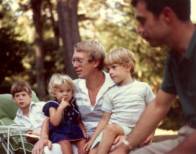 In the summer of 1981, John got together with the Coffees and the Rosenbergs. Frank and Ellie were visiting at Joe and Laurie’s in Virginia, and John and Jerilyn invited them all over to Mount Vernon, where Frank took these photos. In my newsletter, I commented that John looked like someone who was trying to figure out where to find $10 million, didn’t he, and maybe next time Frank could get one with a smile. In that same (1982) edition of the newsletter, John reported that the kids were now in private schools. He had seen Bill Anthony the previous summer, up at Cape Cod, where they went each year, and he was hoping to get together with Llew Haden, who was planning a family trip to Washington. And, as he had promised, John had again hosted a Darrow reception at Mount Vernon, in the spring of 1981, and was planning another for spring of ’82 (which, as the photos above show, also occurred.)
In the summer of 1981, John got together with the Coffees and the Rosenbergs. Frank and Ellie were visiting at Joe and Laurie’s in Virginia, and John and Jerilyn invited them all over to Mount Vernon, where Frank took these photos. In my newsletter, I commented that John looked like someone who was trying to figure out where to find $10 million, didn’t he, and maybe next time Frank could get one with a smile. In that same (1982) edition of the newsletter, John reported that the kids were now in private schools. He had seen Bill Anthony the previous summer, up at Cape Cod, where they went each year, and he was hoping to get together with Llew Haden, who was planning a family trip to Washington. And, as he had promised, John had again hosted a Darrow reception at Mount Vernon, in the spring of 1981, and was planning another for spring of ’82 (which, as the photos above show, also occurred.)
In 1983, I was appointed to the Darrow Board of Trustees, and the stage was set for a new chapter in my long relationship with John. 1983 was Dave Miller’s last year as headmaster, and the Board selected Jerral Miles to succeed him. Miles had boundless energy and creative ideas (too much so, it would eventually turn out), but he had unmistakable leadership ability, and the Board concluded that the time had come to undertake some serious fundraising. Around that time, the Mount Lebanon Shaker Village was also created, to manage the historical site, and the school buildings were deeded to MLSV, opening the possibility that foundation grants and public donations could support the upkeep of the school’s physical plant, always a major element of the school’s annual budget.
The Board decided it was time to hire a high-powered director of development. John, through his work organizing Washington area alumni events, was well known to the development office staff, and Mount Vernon had recently completed a successful $10 million fund drive. Members of the Board’s finance committee actively recruited John; as far as I was aware, he was happy at Mount Vernon and had had no plans to leave. But the appeal of an alumnus who was also a successful fundraiser was strong on the Board’s side, and for John, the opportunity to put his experience and skills to work serving Darrow and the Shaker historical site convinced him. He accepted the offer and returned to Darrow as its new Director of Development in the summer of 1984. I’m not sure, but I think he and Jerilyn moved into Cherry Lane Cottage (Coach Mahnken’s house while we were students). I visited campus that summer and greeted John soon after his arrival. He was enthusiastic and raring to get started.
To put it bluntly, the new job was a disaster for John. The Board had pushed ahead and hired him over the objections of Jerral Miles, who felt John (and the salary the Board had negotiated with him) was too high-powered for the school’s always-tight budget and modest development expectations. Miles never accepted John as a colleague and couldn’t boss him around, since both he and John reported to the Board. Darrow lacked, 20 years ago, the infrastructure of long- and well-cultivated prospects essential for any major fund drive to succeed; if the Board had expected John to push the Annual Fund into the million-dollar range, that was just stardust in their eyes. And the Development Director’s job description was very confusing: Was he raising money for the historical site? For the school? For both, in different ways? The Darrow Board and the MLSV board each had their own ideas about how and where to raise funds, and had not sorted out priorities or coordination strategies. Perhaps a more aggressive, iron-fisted executive than John could have fought his way through this mess and made the ducks line up, but John was too gracious to operate that way. And perhaps Harry Houdini himself could not have escaped the booby-traps that awaited John. He had a miserable year, and given our long acquaintance, he shared his miseries with me, when we saw each other at Board meetings, phonathons, and such. After just about a year, he resigned. Not long after that, the Board parted ways with Jerral Miles, too, and Darrow entered a period of turbulent leadership.
When he left the school’s employ, John dropped off of the radar screen for the Peg Board, and by then, I had stopped doing annual newsletters, so I essentially lost touch with him for a few years. I did call him now and then, either from Darrow telethons or when I was trying to organize another reunion. When I called him in 1987, hoping to persuade him to come to our 25th, I learned he was doing well. He had a new career in executive recruitment, with Raines International, a firm in NYC, and he was enjoying it a lot. He, Jerilyn and the kids had given up their Manhattan apartment and moved to a house they’d bought Brooklyn Heights, although the kids weren’t there much. Jonathan was in college now (I didn’t write down where), and Anna was a sophomore at Emma Willard. They had rented a house in Siena, Italy, for the month of June (so, sorry, they would not make it to our reunion). Anna was going to spend the rest of the summer in Florence, before returning to school. John had gotten together with Huib Soutendijk and his wife, Kathy Markel, in the city, and was looking forward to seeing other members of the class should they be in town.
As far as I recall, that was the last time I spoke with John. About six years later (March 21, 1993), I was stunned to see his obituary in the New York Times. John had died on March 19, of cancer. The obituary called him “a passionate student of the arts and of American history,” and noted his association with Mount Vernon and the Mount Lebanon Shaker Village. It said that during the last few years of his life, he had been a volunteer leader of the AIDS Task Force of the Unitarian Church of All Souls, in Manhattan, where a memorial service was held, on March 24.
John left us far too soon. Though he spent just a year at Darrow, the place got into his blood, as it has a way of doing. He lived a life of steady devotion and service to his work, his family, his friends, his school, and his community. I feel privileged to have known him and worked with him to the extent I did, and wish I’d had the time, or made better use of the time we had, to get to know him a little better.
Home | Class News | 50th Reunion | Past Reunions | Other Gatherings | Newsletter Archive | Links | Memorials | Classmates Search | Classmates Found | Trivia | Former Faculty | Contacts |
 John joined our class for our senior year at Darrow, so he spent just a single year among our ranks. He roomed with Bill Anthony and Bob Sherwood, up in Ann Lee. Like Bob, John hailed from Troy, NY, at that point in his life. He and I were on the JV soccer team together, where as I recall, he played fullback, but I did not know him very well at Darrow. I got to know him a little better over the years after we graduated.
John joined our class for our senior year at Darrow, so he spent just a single year among our ranks. He roomed with Bill Anthony and Bob Sherwood, up in Ann Lee. Like Bob, John hailed from Troy, NY, at that point in his life. He and I were on the JV soccer team together, where as I recall, he played fullback, but I did not know him very well at Darrow. I got to know him a little better over the years after we graduated. John always struck me as very smooth, and socially graceful. We saw him as an urbane sophisticate, or at least that’s what the gag photo with his senior portrait in the yearbook suggests. In the rest of the yearbook, John appears in only that JV soccer team photo, as far as sports go, but he was a member of several clubs and service groups, including the Press Club, the Philosophy and Religion Seminar, and the Art Club, and he worked in the Milk Bar. In his single year at Darrow, John proved easy to like and seemed well rounded and serious about intellectual pursuits.
John always struck me as very smooth, and socially graceful. We saw him as an urbane sophisticate, or at least that’s what the gag photo with his senior portrait in the yearbook suggests. In the rest of the yearbook, John appears in only that JV soccer team photo, as far as sports go, but he was a member of several clubs and service groups, including the Press Club, the Philosophy and Religion Seminar, and the Art Club, and he worked in the Milk Bar. In his single year at Darrow, John proved easy to like and seemed well rounded and serious about intellectual pursuits.



 In May of 1980, John fulfilled his ambition to host a Darrow event at Mount Vernon. These photos from the Peg Board were taken at an almost identical gathering, two years later. Unfortunately, I couldn’t attend, since I had moved to New York in late 1979. But it was a wonderful evening, with cocktails on the South Lawn and patio overlooking the Potomac River, and dinner at the Director’s House. Which, by the way, was now John and Jerilyn’s residence; the Association provided a house at Mount Vernon for its director. John was hoping to make a Darrow reception at Mount Vernon an annual event. When I spoke with him on the phone, he said his work these days was mostly fundraising, but he was still enjoying it, and seemed delighted to be able to serve Darrow in this fashion.
In May of 1980, John fulfilled his ambition to host a Darrow event at Mount Vernon. These photos from the Peg Board were taken at an almost identical gathering, two years later. Unfortunately, I couldn’t attend, since I had moved to New York in late 1979. But it was a wonderful evening, with cocktails on the South Lawn and patio overlooking the Potomac River, and dinner at the Director’s House. Which, by the way, was now John and Jerilyn’s residence; the Association provided a house at Mount Vernon for its director. John was hoping to make a Darrow reception at Mount Vernon an annual event. When I spoke with him on the phone, he said his work these days was mostly fundraising, but he was still enjoying it, and seemed delighted to be able to serve Darrow in this fashion.
 I next saw John in 1981, when the Metropolitan Museum of Art opened its Shaker room. Many of the furnishings on display had come from the North Family Dwelling at Darrow, when it was dismantled by Hands-to-Work crews, after the school acquired the North Family property in 1973. John came up to New York from Mount Vernon for the event, and was joined by John and Jean Joline, and several officials from Darrow. I spoke to him soon afterward, gathering news, and he was as busy as ever at Mount Vernon, preparing to launch a $10 million capital campaign.
I next saw John in 1981, when the Metropolitan Museum of Art opened its Shaker room. Many of the furnishings on display had come from the North Family Dwelling at Darrow, when it was dismantled by Hands-to-Work crews, after the school acquired the North Family property in 1973. John came up to New York from Mount Vernon for the event, and was joined by John and Jean Joline, and several officials from Darrow. I spoke to him soon afterward, gathering news, and he was as busy as ever at Mount Vernon, preparing to launch a $10 million capital campaign.
 In the summer of 1981, John got together with the Coffees and the Rosenbergs. Frank and Ellie were visiting at Joe and Laurie’s in Virginia, and John and Jerilyn invited them all over to Mount Vernon, where Frank took these photos. In my newsletter, I commented that John looked like someone who was trying to figure out where to find $10 million, didn’t he, and maybe next time Frank could get one with a smile. In that same (1982) edition of the newsletter, John reported that the kids were now in private schools. He had seen Bill Anthony the previous summer, up at Cape Cod, where they went each year, and he was hoping to get together with Llew Haden, who was planning a family trip to Washington. And, as he had promised, John had again hosted a Darrow reception at Mount Vernon, in the spring of 1981, and was planning another for spring of ’82 (which, as the photos above show, also occurred.)
In the summer of 1981, John got together with the Coffees and the Rosenbergs. Frank and Ellie were visiting at Joe and Laurie’s in Virginia, and John and Jerilyn invited them all over to Mount Vernon, where Frank took these photos. In my newsletter, I commented that John looked like someone who was trying to figure out where to find $10 million, didn’t he, and maybe next time Frank could get one with a smile. In that same (1982) edition of the newsletter, John reported that the kids were now in private schools. He had seen Bill Anthony the previous summer, up at Cape Cod, where they went each year, and he was hoping to get together with Llew Haden, who was planning a family trip to Washington. And, as he had promised, John had again hosted a Darrow reception at Mount Vernon, in the spring of 1981, and was planning another for spring of ’82 (which, as the photos above show, also occurred.)